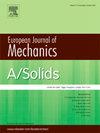Modeling MEMS accelerometer anchor velocity during package drop with a discrete impact model and a transfer function
IF 4.2
2区 工程技术
Q1 MECHANICS
引用次数: 0
Abstract
During everyday use, devices containing MEMS sensors (e.g., smartphones, watches, drones, cars) are accidentally dropped, impacted or endure shocks from the environment. However, as they can hardly be repaired or replaced, impact resistance should be ensured during the entire life-cycle of the sensor.
The simplest drop impact case is the so-called package drop, that is, the sensor package falling on a floor. It is usually modeled with explicit finite element method (FEM) because of the complex geometry of the package and the various materials it includes. While an analytical model encompassing package effects is elusive, a discrete model with parameters fitted to FEM results is presented.
The proposed model consists of two parts: an impact model gives the velocity of the package center of gravity, while a discrete transfer function turns it into an anchor velocity estimate. This in turn can be used as a kinematic constraint in an FEM simulation of the sensor structure, to evaluate its impact robustness. It is shown that a two degrees-of-freedom Kelvin–Voigt impact model with additional spring can adequately model the package drop for reasonable drop heights. Moreover, the transfer function gives an estimation of the anchor movement that fits the FEM solutions with for different drop heights and floor materials, while having a computational time of less than a second instead of hours.

利用离散冲击模型和传递函数对MEMS加速度计在包裹下落过程中的锚速进行建模
在日常使用中,包含MEMS传感器的设备(例如智能手机,手表,无人机,汽车)会意外掉落,撞击或承受环境的冲击。但由于传感器不易维修或更换,因此在传感器的整个生命周期内都要保证其抗冲击性能。最简单的跌落冲击情况就是所谓的封装跌落,即传感器封装掉在地板上。由于包装的几何形状复杂,材料种类繁多,通常采用显式有限元法对其进行建模。考虑包效应的解析模型是难以捉摸的,提出了一个离散模型,其参数与有限元结果拟合。该模型由两部分组成:一个冲击模型给出了包裹重心的速度,而一个离散传递函数将其转化为锚速估计。这反过来又可以用作传感器结构有限元模拟中的运动学约束,以评估其冲击稳健性。结果表明,加附加弹簧的两自由度Kelvin-Voigt冲击模型能充分模拟包裹下落的合理下落高度。此外,传递函数给出的锚杆运动估计与有限元解在R2>;0.75下对不同落差高度和底板材料的拟合,且计算时间小于1秒而不是数小时。
本文章由计算机程序翻译,如有差异,请以英文原文为准。
求助全文
约1分钟内获得全文
求助全文
来源期刊
CiteScore
7.00
自引率
7.30%
发文量
275
审稿时长
48 days
期刊介绍:
The European Journal of Mechanics endash; A/Solids continues to publish articles in English in all areas of Solid Mechanics from the physical and mathematical basis to materials engineering, technological applications and methods of modern computational mechanics, both pure and applied research.

 求助内容:
求助内容: 应助结果提醒方式:
应助结果提醒方式:


